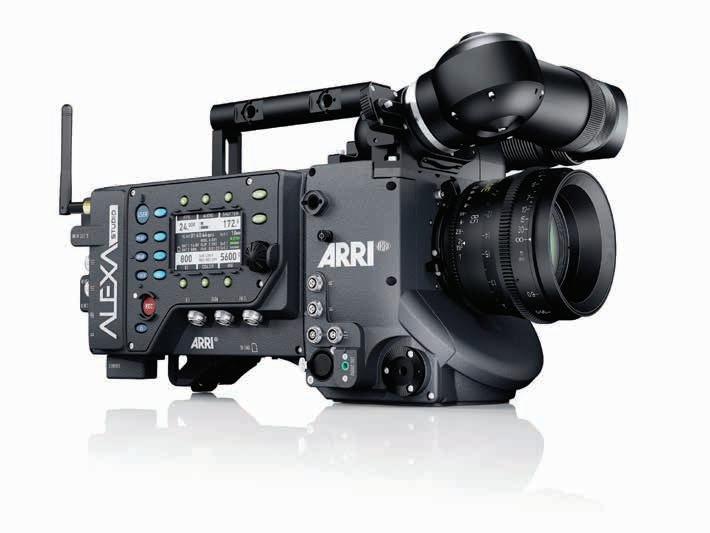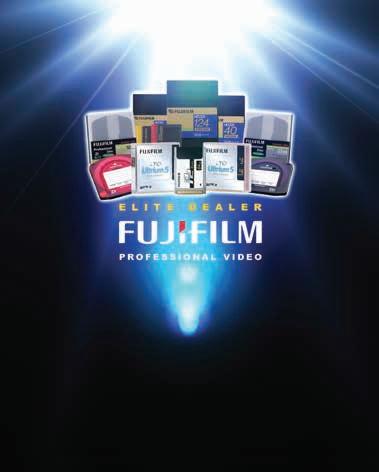
6 minute read
Tech Column
ALEXA Studio: Tradition Integrated with New Technology
By Sarah Moffat
For those of you familiar with the line of ARRI digital cameras, should you come from a film background working with the various ARRIFLEX bodies, you’ll be very excited to try out their new flagship camera, the ALEXA Studio. The Studio is a direct response to cinematographers’ desires for that perfect combination between traditional elements and new technology.
The Studio has integrated all of the amazing functions of the established ALEXA, along with a 4:3 sensor, anamorphic desqueeze, as well as a mechanical mirror shutter and an optical viewfinder. Yes, you are once again able to see straight through the actual taking lens and ground glass yet work in a digital format.
Sébastien Laffoux, Sales Manager for Camera and Digital Systems at ARRI Canada Ltd, had an ALEXA Studio in the office for a brief visit earlier this year, and what a treat it was. The optical viewfinder, OVF, is equipped with ARRIGLOW and all! So great to see again having come from a film background myself. It was so special to look at a real ground glass again after so many years of looking at EVFs and their varied abilities of reproducing the recorded image. The mirror shutter is the same as the one used in the ARRICAMs, and again, such a pleasure to see it here in digital! With the excitement out of the way, we powered the whole thing up. (Yes, you can see through the OVF while power is off!)
The reputation of the ALEXA for picture quality speaks for itself on works such as Breakaway, shot by Steve Danyluk csc. And the Studio only gets better with its mirror shutter. The mirror shutter interacts with the sensor in exactly the same way as it would with a film gate. In fact, on the Studio there are two new buttons: the “view” button parks the mirror shutter over the sensor to reflect the image into the OVF; push “gate”, and the shutter clears the path to expose the sensor and allow for images to stream through all monitoring outputs. Press both “view” and “gate” buttons at once, and the shutter will rotate at the selected frame rate, even when not recording, thus feeding a live image to the OVF and HD monitoring outputs. Now, that doesn’t affect the picture but
this eliminates any kind of rolling shutter artifacts. Unlike the electronic shutter, which scans the sensor from top to bottom, the mirror shutter sweeps across the sensor right to left like in the ARRIFLEX 235, 435, 535 and ARRICAMs.
I spoke with Jérôme Sabourin csc in Montreal, who has shot over 350 days with ALEXA cameras and has used the new Studio as well. He says, “The mirror shutter makes movement and motion on camera look so much like 35 mm. It is amazing, and I love the feel it gives back to digital.” We talked about the challenge of the mirror shutter only going to 60 fps, versus the electronic shutter going up to 120 fps and agree that it is an electronic challenge, not a mechanical one. He adds, “The sensor is not able to capture and reset at that speed. The photosites must fire when exposed, read out when covered, and reset for the next exposure, thus 120 times per second is too fast.” The variable frame rates are: 0.75 fps up to 120 fps in 16:9, electronic shutter only. Mirror shutter in 16:9 is 0.75 fps to 60 fps. In 4:3 full sensor mode mirror or electronic shutter it is 48 fps. This aside, Jérôme expressed great love for the look of the mirror shutter in the Studio.
An interesting feature of the ALEXA Studio is the motorized internal ND filter. Conventional NDs placed in front of the lens may cause a shift in colour and far-red contamination. Inside of the Studio is a motorized filter mechanism which provides an optical flat as well as an ND 1.3 (4.3 stops loss). I asked Sébastien why this choice, and he explained, “We wanted to address the use of the camera outside in bright, high contrast situations, while preserving colour fidelity.” The filter is custom-made by ARRI in order to achieve the same physical thickness between the clear glass and the ND filter, while applying the adequate infrared protection for both settings. The key benefit of ND filtration behind the mirror shutter is that it keeps the optical viewfinder clear and bright for the comfort of the camera operator.
Now let’s talk anamorphic. The 4:3 sensor of the ALEXA Studio can record in ARRIRAW a 2.39 Scope image squeezed 2582x2160, in 2K ProRes mode squeezed 1836x1536 and in HD ProRes mode squeezed 1291x1080, while offering anamorphic de-squeeze for live monitoring in HD letter box 1920x803. You
CSC_Ad_Outlines.pdf 1 12-01-06 10:23 AM VANCOUVER CALGARY TORONTO VANCOUVER CALGARY TORONTO 604-527-7262 403-246-7267 416-444-7000 604-527-7262 403-246-7267 416-444-7000
can also magnify in camera the de-squeezed HD image for a closer look at the wide aspect ratio. I have to say, it was really exciting to see that happen right before my eyes. It truly offers a HALIFAX HALIFAX 902-404-3630 visceral relationship in camera with the anamorphic image you 902-404-3630 are creating and operating on. Jérôme has recently lensed the French-Canadian film Angle Mort with the D-21 in anamorphic, and he had this to say: “The ALEXA has an advantage over all the other anamorphic systems on the market because what you see on set truly represents the final feel of the movie. It’s the same in the editing room. Everything is absolutely correct and it already looks beautiful, which is always good for the DOP. I love that because I can see right away what I’m doing and the ‘wow’ effect Client: _____________________________________________________ Panavisi on Canada on set makes a huge difference.” Docket: ________________ PAN-COR-1 634-08R1 Media: _____________________________________________________ CSC News Placement: ____________ Trim Size: ______________________ 5.25" W x 2.1 25" H Safety: ____________________ N/A Bleed: ________________ N/A Colour: ________________________ B&W Publ. Date: _________________ 201 0 Prod. Date: The ALEXA D-21 is the predecessor to the Studio and was not ____________ Jan 7, 201 0
Tel: 416-423-9825 Fax: 416-423-7629 E-mail: able to record true anamorphic in camera, but now all that has dmaguire@maguiremarketing.com changed. The Studio is the next answer.

Client: _____________________________________________________ Panavisi on Canada Docket: ________________ PAN-COR-1 634-08R1 Media: _____________________________________________________ CSC News With all the ALEXA record and output formats available in Placement: ____________ Trim Size: ______________________ 5.25" W x 2.1 25" H Safety: ____________________ N/A the Studio, the ARRI wireless lens control system, curved out Bleed: ________________ N/A Colour: ________________________ B&W Publ. Date: _________________ 201 0 Prod. shoulder pad, handheld mounts, and more, this camera system Date: ____________ Jan 7, 201 0
Tel: 416-423-9825 Fax: 416-423-7629 E-mail: truly is superior. Add in the mirror shutter, OVF, and anamorphic options, and the bar has been raised. I personally look forward to dmaguire@maguiremarketing.com employing this camera for an anamorphic project soon, as well as seeing the work of others with the ALEXA Studio.
To get more familiar with the ALEXA Studio, contact the teams at ARRI and at your preferred rental house.
Sarah Moffat’s camera experience includes motion picture and still photography. She has worked in narrative, documentary / factual and live broadcast.




